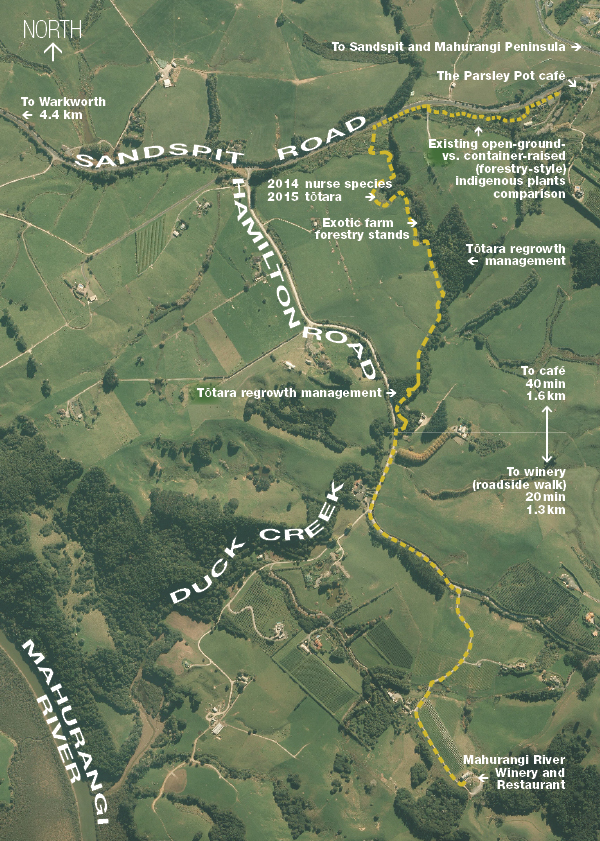Climate action on the farm-forestry trail
Written for Tāne’s Tree Trust Newsletter

What’s Not to Like: With a café at one end and a winery and restaurant at the other, and handy to Warkworth and State Highway 1, the Mahurangi Farm-Forestry Trail is the epitome of accessibility and conviviality. map Mahurangi Magazine
Such have been the negative political consequences of doing so.
It wasn’t until in his final four-year term that President Barack Obama felt he could talk openly about addressing anthropogenic global warming. Similarly, it wasn’t until safely at his side, that Prime Minister John Key has been happy to be the president’s ‘excellent’ climate-action ‘partner’.
President Obama’s belated regulation of power-plant carbon dioxide emissions will likely coincide with a rash of new climate records, thanks to help from the onset of another, increasingly stronger, El Niño, and the inevitable conclusion to the ‘Arctic death spiral’, next year. The imperative for an all-of-the-above response will include tree planting on a scale of the New Zealand Forest Service, in its 1970s–80s heyday. In the rush, it is important that opportunities are not lost for some of those trees to be indigenous—many property holders, who were otherwise predisposed to planting to indigenous species, may be stampeded into planting radiata pine. This is where the Mahurangi Farm-Forestry Trail can help.
The farm-forestry trail came about as a direct result of brainstorming with Dr David Bergin on a field day bus, at the 2009 indigenous forestry conference that celebrated Tāne’s Tree Trust’s first decade. The discussion was of the need to establish good indigenous forestry demonstration sites in readily accessible locations. Meantime, an ideally accessible site existed on the busy Sandspit Road 4.4 kilometres outside Warkworth, next door to The Parsley Pot café. It was already demonstrating the comparative establishment performance of open-ground and container raised plants—the first such scientifically designed comparison, which directly led to Tāne’s Tree Trust’s trials at Waihaha, Taupō. During discussion of a second phase to involve succession species with the property holder Shelley Trotter, Shelley laid out her vision for an adjacent streamside trail, and for a larger network of trails. Because the stream, Duck Creek, already ran past several exotic farm forestry stands, the opportunity for a farm-forestry trail was irresistible.
Duck Creek was already of interest to Auckland Council, being a priority subcatchment in the Mahurangi Action Plan, a council and community response to the elevated sediment accumulation rate in the Mahurangi Harbour. With the impetus of the then upcoming 2013 New Zealand Farm Forestry Association conference, and funding that came available at short notice from the Rodney Local Board, the 1.6-kilometre trail was surveyed and signposted. A subsequent grant has seen the trail formed and bridges and culverts installed. In addition to the exotic stands, two pairs of demonstration plots of productively managed regrowth totara have been measured—the most southerly demonstrations of the regime pioneered by the Northland Tōtara Working Group.
In August, the first of the new farm-forestry plantings will commence, with nurse species being planted by Trees for Survival. Next year, two plots will be interplanted with tōtara raised by Taupō Native Plant Nursery by the open-ground method. One block will be planted at 1372 stems per hectare (2.7-metre spacing) and the other block at 3086 (1.8-metre spacing). A third block will be planted at 3086 stems per hectare, but with no nurse species. The plantation will subsequently be thinned to a final density of 500–600 stems per hectare.
Indigenous farm-forestry, with its emphasis on actively growing trees and wood products suitable for substitution of high-carbon materials, can play a useful role in reducing greenhouse gas emissions. The Mahurangi Farm-Forestry Trail provides a perfect opportunity to literally walk farmers and decision makers through the possibilities, having rendezvoused at The Parsley Pot, and culminating, at the far end, at the Mahurangi River Winery and Restaurant.
Project coordinated by Mahurangi Action
See also Open-Ground Indigenous Plants Report
